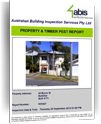What ABIS Inspects at Lock-Up Stage:
- Roofing installed and complete to Standards & manufacturer specifications.
- Roof plumbing.
- Appropriate flashings to openings and penetrations checked for fitting and condition.
- Visually check for the installation of damp proofing.
- Weep holes to perimeter and window openings.
- Brickwork is straight and plumb with sound mortar. Sill bricks secure and brick control joints appropriately sealed to exclude water ingress.
- Windows and doors are fitted using appropriate blocks and fixings to maintain the frame straight and true.
- Ceilings, wall linings and cornice fitted to acceptable standards with comment on the quality of finish and any obvious defects.
- Internal paint finish.
- External paint finish.
- Waterproof membrane to showers & wet areas.
- Fire separation walls where required, checked whether complete to Standards and manufacturer specifications.
- Ventilation including subfloor ventilation.
Information on Waterproofing
The importance of waterproofing is reflected in the consequences of not waterproofing. Water which enters or escapes from buildings can have immediate and long-term undesired consequences including damage to building contents and long-term structural damage if the problem is not successfully dealt with quickly. Building materials have a considerably shorter lifespan when subjected to moisture over a prolonged period of time. Water damage is second only to fire as a cause of building decay and deterioration.
Internal areas that need to be waterproofed include bathrooms, shower recesses, laundries, and toilets. External areas which commonly need to be waterproofed include external roofs, planter boxes, balconies, retaining walls and swimming pools.
The casualties of water damage include:
- Rotting timber structures and finishes
- Corrosion of metals such as steel reinforcement in concrete, steel beams, lintels
- Swelling of plaster boards and subsequent debonding of ceramic tiles
- Electrical hazards causing possible short-circuiting of lighting and power points
- Blistering of paints
- Unsightly deterioration of the building façade
- Health problems due to dampness which may lead to respiratory problems
- Rotting carpet
The importance of waterproofing cannot be overstated. The damage caused to the building coupled with the high cost of rectification warrants the careful design and application of waterproofing.
To protect a building’s visual and structural integrity, a membrane must:
- Be impermeable to water
- Accommodate any normal movement that may occur in structures
- Be durable, retaining its integrity over time
- Be suitable for its application
- Be able to breathe permitting escape of moisture vapours
- Be compatible with adhesives to ensure long-term adhesion
- Be user-friendly, easy to apply, relatively lightweight, non-hazardous, environmentally safe
- Require little maintenance or be easily repairable
- Provide continuous protection
- Withstand environmental and climatic conditions.
The keys to waterproofing effectiveness are:
- Proper consideration at the design stage
- Choosing the right product for the job
- Adequate preparation
- The correct application
Leaking Showers:
The following is a summary of the most common problems associated with leaking showers.
- Leaks through or around doors or screens
- Water getting behind poorly sealed tap & spout flanges into the wall cavity
- Use of “standard” floor wastes in tiled floors which are difficult to seal and do not provide drainage from the base area
- Use of “smooth” floor wastes to which the membrane does not adhere
- Timber used to form the hub of the shower which swells & disrupts waterproofing
- The surface of the hob sloping “out” rather than “in” so water is directed outside the shower
- Positioning the screens or doors to the outside edge of the hob rather than overhanging the inside edge slightly so that the top of the hob is subjected to continual water testing
- Leaking tap body washers either not tightened at installation or after maintenance
- Nails or screws embedded in the pipework or touching copper pipes causing corrosion
- No flashing in the internal corners behind the wall lining
- No bond breaker at angles/corners
- Wall lining extending too far down into the tray causing “wicking”
- Recessed slab method with no waterproofing
- Nails or screws through the side or bottom of the tray
- Tiling before the membrane is fully cured
- Damage to waterproofing systems by carelessness of following trades
- Use of a non-approved wet area system
Minimum Waterproofing Requirements:
The Building Code of Australia (1996) and the Australian Standard (AS 3740-1994) “Waterproofing of Wet Areas in Residential Buildings” require that the following areas within a bathroom must be waterproofed:
- Full floor within the shower recess including down into the waste or if the shower is not enclosed, within 1.5 meters horizontally from a point vertically below the shower fitting
- If the shower is enclosed, minimum 100mm over the hob or step-down onto the bathroom floor
- If the shower is enclosed and exposed to a shower fitting to a height 1.8 meters above the floor or to a height no less than 150mm above the shower rose if it is within 75mm of the wall
- Immediately behind a bath, trough, sink or similar fixture
- The junction between the floor and wall of the shower; the junction between the wall and the fixture (the flange)
- The full bathroom floor if it is made from timber, plywood or particle board or is above the ground floor
- Tiled finishes over fibre reinforced cement sheeting or moisture resistant plasterboard provide an acceptable wet area lining except at the junction surfaces where additional precautions are necessary.
- A generous bead (10mm wide) of silicone should also be applied to:
- All wall/floor junctions within the shower
- Junctions between 2 wall sheets within the shower recess up to where the tiling finishes
- The perimeter of the waste outlet/floor junction
- The silicone should be smoothed over so that it extends 5mm either side of each junction.
Many councils now require that new waterproofing work to be performed by licensed waterproofing applicators and a certificate be issued once it has been approved by a certifier.



